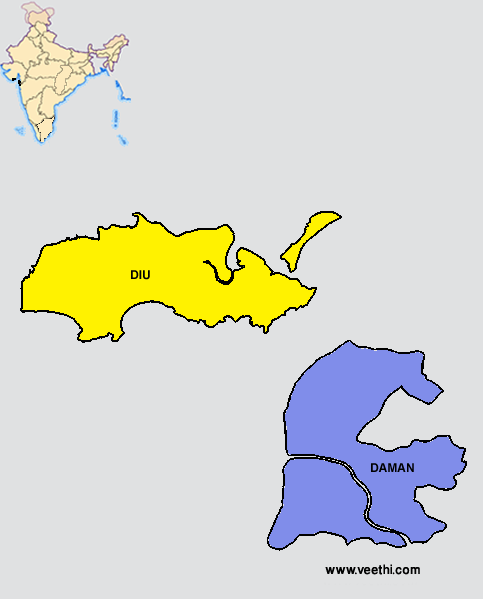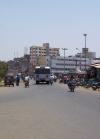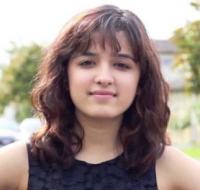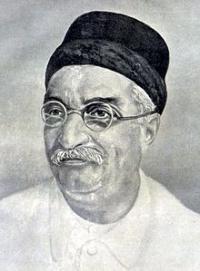Daman and Diu is a Union Territory of India located in the coast of Arabian Sea. The capital of Daman and Diu is Daman. It was a territory of Portuguese until it was brought under the control of India in 1961.
History of Daman and Diu
The history of Daman and Diu starts from the time of Emperor Ashoka in 2nd century B.C. Gautamaputra Satakarnin ruled this place in 125 A.D. Then Traikutakas and Rashtrakutas ruled this place. In 13th century, Ramsingh, a Rajput prince defeated the Koli chief Nathorat and established his kingdom. Portuguese came into the scene in 1523 and since then it remained their enclave for four long centuries. The colonial rule was put to an end on 19th December 1961 when the region was conquered by the military. However Portuguese refused to accept this annexation till 1975.
Geography and Climate of Daman and Diu
Daman and Diu spreads over an area of 112 square kilometers. In this, Diu district occupies an area of 40 square kilometers. Daman has Gujarat on the east, Arabian Sea on the west, Kolak River on the north and Kalai River on the south. Diu is an island and is connected by two bridges. The climate of Daman is pleasant throughout the year. The cool breeze from Arabian Sea makes the climate pleasant in summer. The maximum temperature of Daman and Diu is 38.80 degree Celsius and the minimum temperature of Daman and Diu is 11.40 degree Celsius. The average annual rainfall of Daman and Diu is 1687 mm.
Daman and Diu State Map With Districts

People and Culture of Daman and Diu

As of 2011 census, the population of Daman and Diu is 242,911 people among which 150,100 are males and 92,811 are females. The density of population is 2169 people per square kilometers. English, Hindi, Gujarati and Marathi are the official languages. Some people also speak Portuguese language. The sex ratio is 618 females for every 1000 males. Daman and Diu has a rich cultural heritage. It is a fusion of tribal, urban, European and Indian cultures. The traditional dances of this region reflect this amalgamation of cultures.
Education in Daman and Diu
The literacy rate of Daman and Diu as per 2011 census report is 87.07% and in that the male literacy rate is 91.48% and female literacy rate is 79.59%. In 2001, the total literacy rate was only 78.18% and the region has witnessed a good growth over a period of 10 years. Some of the good schools that contributed to that is Jawahar Navodaya Vidyalaya, Government Secondary School, Nirmala Mata Secondary School, Coast Guard Public School, Home School and Institute of Our Lady of Fatima Convent High School, etc.
Some of the institutions of higher education in Daman and Diu are Daman and Diu Arts College, Daman and Diu Polytechnics and Government Polytechnic.
Economy of Daman and Diu
The gross domestic product of 2005 was $156 million. There are 2930 small scale and medium scale industries in Daman and Diu. Omnibus Industrial Development Corporation has developed two industrial areas in Daman. Other industrial areas are located at Dabhel, Bhimpore, Kachigam and Kadaiya. The central sector power stations provide enough power to Daman and Diu.
The territory has 393.93 hectares of land under irrigation and 3304.73 hectares are un-irrigated as per the agricultural census of 2001. The important crops grown here are paddy, ragi, wheat, pulses, groundnut, bajra, jowar, sapota, mango, chickoo, coconut and sugarcane.
Daman and Diu Transportation
Daman has a total road length of 191 kilometers and Diu has 78 kilometers. There is not railway station here and the nearest railway station is Vapi on the Mumbai to Delhi route. Devada, the meter gauge railway station is the nearest station from Diu. There are airports both in Daman and Diu and are connected by air to the other parts of India. Regular flight services to Mumbai are available from Diu.
The bridge between Moti Daman and Nani Daman over the Daman Ganga River was collapsed in 2003 and so a new bridge was built which is at present opened only to two wheelers and three wheelers. A new bridge called Rajeev Gandhi Setu has been built for Heavy Vehicles.
Daman and Diu Tourism
The climate of Daman and Diu is one of the welcoming features that promote tourism here. Some of the places of interest in Daman are
1. Born Jesus Church
2. Our Lady of Sea Church
3. Our Lady of Remedios Church
4. Forts of Moti Daman and Nani Daman
5. Jampore and Devka Beaches
6. Public Garden
7. Moti Daman Jetty
8. Pargola Garden
9. Amusement Park at Devka
10. Damanganga Tourist Complex
11. Satya Sagar Udyan
12. Mirasol Garden
13. Mirasal Water Park
Some of the places of interest in Diu are
1. St. Paul’s Church
2. Diu Fort
3. Panikota Fort
4. Nagoa
5. Chakratirth
6. Children’s Park at Ghoghla
7. Summer House






















